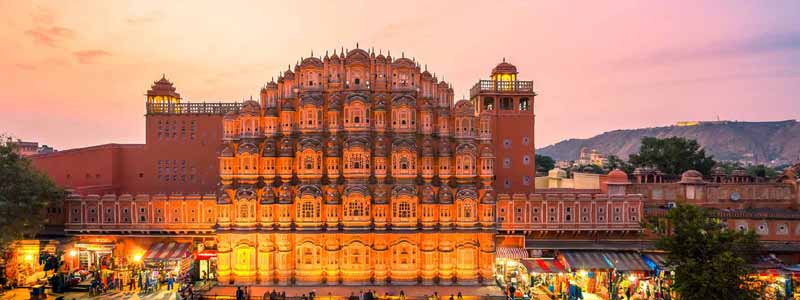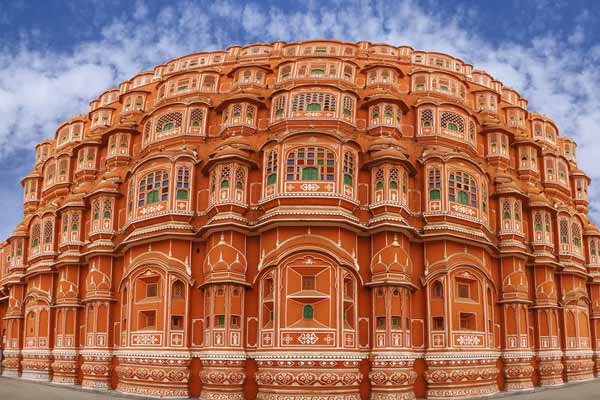Hawa Mahal in Jaipur is regarded as one of the city’s most famous landmarks. The five-story structure resembles a beehive’s honeycomb, and the multiple windows and jharokhas ensure that it is still windy inside. The Hawa Mahal, which literally translates to “Palace of the Winds,” was named after the incredible ventilation that the palace enjoys.
The main aim of the palace’s construction was to enable the royal family’s and court’s ladies to view the busy streets of the Johari Bazaar from the palace’s many jharokhas without being seen. The Hawa Mahal in Jaipur is a five-story structure that stands alone as the world’s tallest structure constructed without a base. It has a pyramidal shape and a curved construction that leans at an 87-degree angle, which has helped it remain upright for decades.
Lord Krishna is honoured at the Hawa Mahal. It is said that the structure’s form resembles Krishna’s crown. The Hawa Mahal in Jaipur is more than just a palace; it’s a cultural and architectural wonder that represents a truly harmonious blend of Hindu Rajput and Islamic Mughal architectural styles. The domes, canopies, and fluted pillars are Rajput in style, while the stone inlay filigree work, and the arches are Mughal in style.

Hawa Mahal Architecture
One of the best places to visit in Jaipur is the Hawa Mahal in Jaipur, which features a magnificent fusion of Islamic, Mughal, and Rajput architectural styles. The rich Rajput style is reflected in the domed canopies, floral designs, lotus motifs, and fluted pillars. The stone filigree work and luxurious arches, both of which are influenced by the Islamic style of architecture, complement these elements.
This one-of-a-kind palace has a pyramidal shape and is made of red and pink sandstone. It consists of five floors and reaches a height of 50 feet. The 953 windows on the palace’s front give it a honeycombed hive appearance. As a result of the excellent latticework on these windows, the palace is kept cool by the breeze that comes in through them. Another appealing feature of the Hawa Mahal’s architecture is the delicately carved hanging cornices.
The palace’s interiors are made up of pillared chambers and sparsely ornamented corridors that extend all the way to the top floor. Patios adorn the first and second floors’ front halves. The top three floors, unlike the lower two, have a width of no more than a single bed. The courtyard of the building has fountains in the middle Hawa Mahal in Jaipur.
Hawa Mahal: History
Maharaja Sawai Pratap Singh, the grandson of Maharaja Sawai Jai Singh, designed the Hawa Mahal in Jaipur in 1799. When Pratap visited Jhunjhunu and saw Khetri Mahal, the storey of the palace’s birth began.
The unusual nature of the Khetri Mahal drew Maharaj’s attention, and he decided to construct a better version of it. This palace was built by Lal Chand Ustad, who created one of the greatest monuments in history.
The main reason for building this palace was to have a separate space for royal women. They could watch the daily lives and festival festivities through the windows of Hawa Mahal in Jaipur without being seen because they couldn’t go out in public without a veil.
The Hawa Mahal in Jaipur was a part of the main City Palace, and the royal family would come here to avoid the sweltering heat because the palace was still cool and breezy thanks to its many windows. It has been maintained since then in order to pass on the glory and grace to future generations.
Best Time to Visit in Hawa Mahal
The best time to visit is early in the morning, when the palace is bathed in golden light. To prevent dust accumulation, the structure’s windows are usually closed. As a result, enjoying the wind rushing into the palace is not always possible Hawa Mahal in Jaipur.
From 9:30 a.m. to 4:30 p.m., the palace is open. You should take a walk near the palace at night to see it lit up with lights. The palace is open all year, but the best months to visit are October to March.
Attractions near Hawa Mahal
- Jantar Mantar (700 m)
- Govind Dev Ji Temple (750 m)
- City Palace (850 m)
- Jaipur Zoo (2 km)
- Albert Hall Museum (2.4 km)
- Raj Mandir Cinema (3.7 km)
- Dolls Museum (3.8 km)
- Central Park (4.4 km)
- Birla Mandir (4.5 km)
- Jal Mahal (5 km)
- Kanak Vrindavan Garden (5.3 km)
- Rambagh Palace (5.4 km)
- Amber Palace (7.9 km)
Hawa Mahal in Jaipur is located in a prime location in Jaipur and counts among the top historical places to visit in and around Jaipur. And while you are here, don’t forget to take some amazing pictures with this majestic palace as the backdrop.
